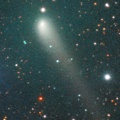
|
Now it is 9.0 mag (Jan. 31, Seiichi Yoshida). It brightens up to 8 mag in spring, and it is observable in good condition in the Northern Hemisphere. In the Southern Hemisphere, it is not observable until July.
Date(TT) R.A. (2000) Decl. Delta r Elong. m1 Best Time(A, h)
Feb. 1 2 16.19 57 58.7 1.627 2.038 99 9.0 18:54 (156, 63)
Feb. 8 2 9.70 58 31.7 1.659 1.985 93 8.9 19:00 (149, 59)
|
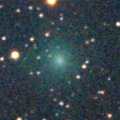
|
Now it is very bright as 10.9 mag (Jan. 31, Seiichi Yoshida). It stays 11 mag until February. In the Northern Hemisphere, it stays observable in good condition after this. It is not observable in the Southern Hemisphere.
Date(TT) R.A. (2000) Decl. Delta r Elong. m1 Best Time(A, h)
Feb. 1 18 19.19 28 14.6 1.147 1.062 59 11.1 5:32 (260, 38)
Feb. 8 18 34.73 38 58.7 1.029 1.114 67 11.0 5:28 (247, 43)
|
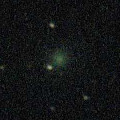
|
Now it is bright as 11.4 mag (Jan. 31, Seiichi Yoshida). It approaches to Sun down to 0.84 a.u. in March, then it brightens up to 10 mag. In the Northern Hemisphere, it stays observable for a long time, although it becomes extremely low in March. In the Southern Hemisphere, it is not observable until June when it fades down to 13 mag. It seems to be a fragment of C/1988 A1 (Liller), like C/1996 Q1 (Tabur) and C/2015 F3 (SWAN).
Date(TT) R.A. (2000) Decl. Delta r Elong. m1 Best Time(A, h)
Feb. 1 23 44.19 -5 45.0 1.654 1.149 42 11.7 18:54 ( 66, 22)
Feb. 8 23 46.98 -0 17.0 1.646 1.068 38 11.4 19:00 ( 76, 20)
|

|
Now it is 12.4 mag (Jan. 29, Maik Meyer). It stays bright as 12-13 mag until summer. But it becomes low in spring. In the Southern Hemisphere, it will never be observable again.
Date(TT) R.A. (2000) Decl. Delta r Elong. m1 Best Time(A, h)
Feb. 1 23 36.80 42 18.5 3.419 3.224 70 12.2 18:54 (118, 43)
Feb. 8 23 40.72 43 13.3 3.507 3.242 66 12.3 19:00 (121, 38)
|
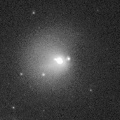
|
It brightened in outburst on Feb. 3. Now it is bright as 12.0 mag (Feb. 4, Bob King). It will be unobservable soon in the Southern Hemisphere.
Date(TT) R.A. (2000) Decl. Delta r Elong. m1 Best Time(A, h)
Feb. 1 0 41.98 13 36.4 6.151 5.787 63 13.7 18:54 ( 73, 45)
Feb. 8 0 45.98 13 54.4 6.250 5.788 57 13.7 19:00 ( 79, 40)
|
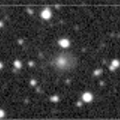
|
Now it is bright as 13.8 mag (Dec. 28, Chris Wyatt). It stays 14 mag until spring. It stays observable for a long time in the Southern Hemisphere. It is not observable until August in the Northern Hemisphere.
Date(TT) R.A. (2000) Decl. Delta r Elong. m1 Best Time(A, h)
Feb. 1 0 40.52 -69 55.0 3.827 3.483 62 14.1 18:54 ( 15,-19)
Feb. 8 0 53.35 -67 1.2 3.850 3.494 61 14.2 19:00 ( 18,-18)
|
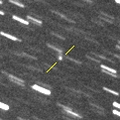
|
In the Southern Hemisphere, it is observable at 14.5 mag from winter to spring. In the Northern Hemisphere, it is not observable until August when it fades down to 17 mag.
Date(TT) R.A. (2000) Decl. Delta r Elong. m1 Best Time(A, h)
Feb. 1 22 41.98 -73 12.2 2.362 2.018 57 14.4 18:54 ( 19,-29)
Feb. 8 23 48.13 -70 44.7 2.324 2.014 59 14.4 19:00 ( 20,-25)
|
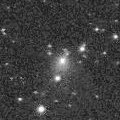
|
Now it is 14.1 mag (Jan. 12, Sandor Szabo). It will be fading after this, and will be fainter than 18 mag in May. In the Northern Hemisphere, it is observable in excellent condition. It locates low in the Southern Hemisphere.
Date(TT) R.A. (2000) Decl. Delta r Elong. m1 Best Time(A, h)
Feb. 1 3 46.35 17 54.9 0.992 1.590 107 15.0 19:04 ( 0, 73)
Feb. 8 4 2.32 16 45.5 1.051 1.600 103 15.2 19:00 ( 6, 72)
|
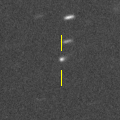
|
Now it is 16.0 mag (Jan. 1, Toshihiko Ikemura, Hirohisa Sato). It will brighten up to 13.5-14 mag from 2020 to 2021. It stays observable in good condition for a long time after this until 2020 summer.
Date(TT) R.A. (2000) Decl. Delta r Elong. m1 Best Time(A, h)
Feb. 1 13 15.86 12 30.4 2.914 3.475 117 15.2 4:34 ( 0, 67)
Feb. 8 13 17.05 12 57.7 2.814 3.457 123 15.1 4:08 ( 0, 68)
|
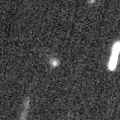
|
Now it is 15.6 mag (Jan. 4, Toshihiko Ikemura, Hirohisa Sato). It will brighten up to 10.5 mag from 2020 December to 2021 January. In the Northern Hemisphere, it stays observable in good condition while the comet will be brightening gradually, but it is not observable at the high light. In the Southern Hemisphere, it is not observable for a long time, but it will be observable in good condition after the high light.
Date(TT) R.A. (2000) Decl. Delta r Elong. m1 Best Time(A, h)
Feb. 1 18 21.33 61 48.7 3.939 3.974 84 15.5 5:32 (215, 44)
Feb. 8 18 27.64 62 37.1 3.868 3.909 85 15.4 5:28 (214, 45)
|
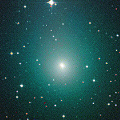
|
It brightened up to 8.3 mag in September (Sept. 20, Maik Meyer). Now it is fading. It has already faded down to 14.9 mag (Dec. 28, Chris Wyatt). In the Southern Hemisphere, it stays observable for a long time after this. In the Northern Hemisphere, it will never be observable again.
Date(TT) R.A. (2000) Decl. Delta r Elong. m1 Best Time(A, h)
Feb. 1 22 37.28 -47 48.6 3.184 2.468 36 15.4 18:54 ( 43,-16)
Feb. 8 22 46.43 -48 15.4 3.253 2.537 37 15.6 19:00 ( 45,-20)
|

|
Now it is 14.6 mag (Dec. 28, Chris Wyatt). It will be fading slowly after this. In the Southern Hemisphere, it becomes low from February to March, but it stays observable for a long time. In the Northern Hemisphere, it is not observasble until June.
Date(TT) R.A. (2000) Decl. Delta r Elong. m1 Best Time(A, h)
Feb. 1 22 45.86 -49 28.1 4.203 3.494 39 15.5 18:54 ( 40,-16)
Feb. 8 22 53.66 -47 32.8 4.258 3.524 37 15.6 19:00 ( 45,-19)
|
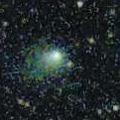
|
Now it is 15.1 mag (Dec. 27, Toshihiko Ikemura, Hirohisa Sato). Fading slowly. It is already unobservable in the Southern Hemisphre. It will be unobservable in early March also in the Northern Hemisphere.
Date(TT) R.A. (2000) Decl. Delta r Elong. m1 Best Time(A, h)
Feb. 1 23 28.84 -5 34.4 2.645 1.985 39 15.5 18:54 ( 69, 19)
Feb. 8 23 45.29 -4 13.3 2.719 2.015 36 15.6 19:00 ( 73, 17)
|

|
It brightened up to 7.7 mag in June in 2018 (June 19, Juan Jose Gonzalez). Now it is fading. It has already faded down to 14.7 mag (Dec. 31, Toshihiko Ikemura, Hirohisa Sato). In the Southern Hemisphere, it stays observable for a long time until the comet will fade out. In the Northern Hemisphere, it stays low for a while.
Date(TT) R.A. (2000) Decl. Delta r Elong. m1 Best Time(A, h)
Feb. 1 5 39.77 -28 1.3 5.392 5.870 114 15.5 20:55 ( 0, 27)
Feb. 8 5 36.45 -26 47.2 5.504 5.925 110 15.6 20:24 ( 0, 28)
|
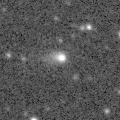
|
Now it is 14.9 mag (Jan. 20, Toshihiko Ikemura, Hirohisa Sato). It will fade out rapidly after this, and it will be fainter than 18 mag in late March. In the Southern Hemisphere, it is already unobservable.
Date(TT) R.A. (2000) Decl. Delta r Elong. m1 Best Time(A, h)
Feb. 1 23 24.42 4 48.8 2.469 1.874 43 15.7 18:54 ( 78, 25)
Feb. 8 23 40.23 6 54.6 2.531 1.894 40 15.9 19:00 ( 83, 22)
|
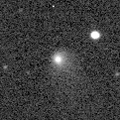
|
Now it is 14.8 mag (Dec. 28, Chris Wyatt). Fading slowly. It will be unobservable soon. It will appear in the morning sky in April in the Southern Hemisphere, or in June in the Northern Hemisphere.
Date(TT) R.A. (2000) Decl. Delta r Elong. m1 Best Time(A, h)
Feb. 1 23 22.66 -19 13.9 5.766 4.991 35 15.7 18:54 ( 59, 9)
Feb. 8 23 27.32 -18 2.3 5.859 5.027 29 15.8 19:00 ( 64, 5)
|
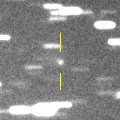
|
First return of a new periodic comet discovered in 2006. Now it is 15.8 mag (Nov. 29, Toshihiko Ikemura, Hirohisa Sato). It will brighten up to 15.5 mag in spring. But it is not observable around that time.
Date(TT) R.A. (2000) Decl. Delta r Elong. m1 Best Time(A, h)
Feb. 1 22 53.60 -12 38.7 2.585 1.788 28 15.8 18:54 ( 69, 8)
Feb. 8 23 12.00 -11 27.9 2.590 1.766 26 15.8 19:00 ( 72, 6)
|
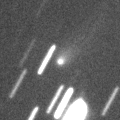
|
Now it is 16.2 mag (Jan. 21, Thomas Lehmann). The orbit is extremely hyperbolic with e=3.35. It is the first interstellar comet in history. It will be fading after this, and will be fainter than 18 mag in April. In the Southern Hemisphere, it is observable in excellent condition. In the Northern Hemisphere, it will never be observable again.
Date(TT) R.A. (2000) Decl. Delta r Elong. m1 Best Time(A, h)
Feb. 1 12 44.78 -55 5.5 2.076 2.341 92 15.8 4:03 ( 0, 0)
Feb. 8 12 50.65 -58 19.2 2.129 2.424 95 16.0 3:42 ( 0, -3)
|
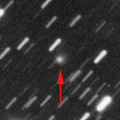
|
Now it is 15.3 mag (Jan. 5, Toshihiko Ikemura, Hirohisa Sato). It is expected to be observable at 5-6 mag for a long time from 2022 to 2023. In the Northern Hemisphere, it is not observable at the high light from 2022 summer to 2023 summer. In the Southern Hemisphere, it stays unobservable for a while. But it will be observable in good condition at the high light.
Date(TT) R.A. (2000) Decl. Delta r Elong. m1 Best Time(A, h)
Feb. 1 18 5.13 45 57.2 10.130 9.904 74 16.0 5:32 (237, 46)
Feb. 8 18 8.14 46 14.8 10.054 9.855 75 15.9 5:28 (237, 49)
|

|
Now it is 16.3 mag (Jan. 19, Toshihiko Ikemura, Hirohisa Sato). It will be fading gradually after this. It will be fainter than 18 mag in April.
Date(TT) R.A. (2000) Decl. Delta r Elong. m1 Best Time(A, h)
Feb. 1 9 15.75 6 36.3 2.054 3.025 168 16.0 0:35 ( 0, 61)
Feb. 8 9 10.03 7 7.6 2.079 3.058 171 16.2 0:02 ( 0, 62)
|
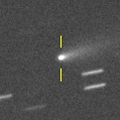
|
Now it is 15.6 mag (Jan. 22, Thomas Lehmann). It will fade out rapidly after this, and it will be fainter than 18 mag in March.
Date(TT) R.A. (2000) Decl. Delta r Elong. m1 Best Time(A, h)
Feb. 1 11 30.73 13 11.5 1.116 1.989 142 16.2 2:50 ( 0, 68)
Feb. 8 11 30.03 13 52.9 1.109 2.021 149 16.4 2:21 ( 0, 69)
|
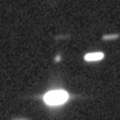
|
Now it is 16.9 mag (Jan. 2, Kunihiro Shima). It will brighten up to 13 mag in 2021. In 2020, it is observable at 15 mag in good condition from spring to summer.
Date(TT) R.A. (2000) Decl. Delta r Elong. m1 Best Time(A, h)
Feb. 1 15 0.23 -14 14.5 5.685 5.677 84 16.3 5:32 (345, 39)
Feb. 8 15 1.59 -14 46.6 5.526 5.634 91 16.2 5:28 (352, 40)
|
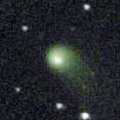
|
It will be fading slowly after this. In the Southern Hemisphere, it stays observable in good condition for a long time. It will never be observable after this in the Northern Hemisphere.
Date(TT) R.A. (2000) Decl. Delta r Elong. m1 Best Time(A, h)
Feb. 1 14 20.42 -69 23.0 4.890 4.762 76 16.2 5:32 (359,-14)
Feb. 8 14 10.85 -71 2.7 4.856 4.806 81 16.2 5:03 ( 0,-16)
|
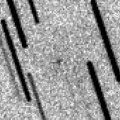
|
Now it is 16.7 mag (Jan. 21, Toshihiko Ikemura, Hirohisa Sato). It became much brighter than in early January. Now it is passing only 0.1 a.u. from Earth. Michael Jager reported it has a faint coma with a diameter of 50-60 arcsec. It is obesrvable in excellent condition in the Northern Hemisphere. It becomes observable also in the Southern Hemisphere.
Date(TT) R.A. (2000) Decl. Delta r Elong. m1 Best Time(A, h)
Feb. 1 8 51.56 54 36.4 0.175 1.130 142 16.3 0:09 (180, 70)
Feb. 8 9 14.61 47 31.7 0.225 1.183 147 16.8 0:06 (180, 77)
|
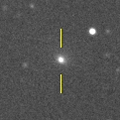
|
Now it is 15.5 mag (Jan. 20, Toshihiko Ikemura, Hirohisa Sato). It will be fading slowly after this.
Date(TT) R.A. (2000) Decl. Delta r Elong. m1 Best Time(A, h)
Feb. 1 1 13.23 2 54.0 2.558 2.351 66 16.5 18:54 ( 54, 44)
Feb. 8 1 24.83 4 15.6 2.636 2.356 62 16.6 19:00 ( 61, 41)
|
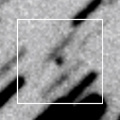
|
Now it is 16.5 mag (Dec. 27, Toshihiko Ikemura, Hirohisa Sato). It stays observable at 17 mag from 2020 to 2021. It locates somewhat low in the Northern Hemisphere.
Date(TT) R.A. (2000) Decl. Delta r Elong. m1 Best Time(A, h)
Feb. 1 10 58.05 -25 22.3 5.962 6.612 127 16.6 2:17 ( 0, 30)
Feb. 8 10 56.64 -25 18.5 5.890 6.607 133 16.6 1:48 ( 0, 30)
|
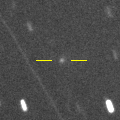
|
Now it is 16.7 mag (Jan. 24, Thomas Lehmann). It moves along the same orbit as C/1844 Y1 (Great Comet). It approaches to Sun down to 0.25 a.u. on May 30. It is expected to brighten up to 6 mag. In the Northern Hemisphere, it stays observable in excellent condition until mid May when it brightens up to 9 mag. In the Southern Hemisphere, it will be unobservable soon.
Date(TT) R.A. (2000) Decl. Delta r Elong. m1 Best Time(A, h)
Feb. 1 11 49.94 42 17.5 1.645 2.446 135 17.0 3:09 (180, 83)
Feb. 8 11 45.43 45 49.0 1.519 2.342 137 16.6 2:37 (180, 79)
|

|
Now it is 17.5 mag (Dec. 28, Toshihiko Ikemura, Hirohisa Sato). It stays 16-17 mag for a long time until 2020. It is observable in good condition in the Northern Hemisphere. In the Southern Hemisphere, it is observable in the extremely low sky only in 2021 spring.
Date(TT) R.A. (2000) Decl. Delta r Elong. m1 Best Time(A, h)
Feb. 1 13 30.54 54 19.3 8.198 8.680 116 16.8 4:49 (180, 71)
Feb. 8 13 29.56 54 42.8 8.172 8.689 118 16.8 4:20 (180, 70)
|
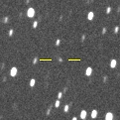
|
Now it is 16.7 mag (Dec. 3, D. Buczynski). It will stay at 14 mag for a long time from 2021 to 2022. In the Northern Hemisphere, it stays observable in good condition while brightening gradually. In the Southern Hemisphere, it is not observable until March.
Date(TT) R.A. (2000) Decl. Delta r Elong. m1 Best Time(A, h)
Feb. 1 19 2.47 29 38.4 7.439 6.910 54 16.9 5:32 (253, 30)
Feb. 8 19 5.31 29 40.4 7.380 6.876 55 16.9 5:28 (255, 34)
|
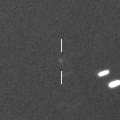
|
Now it is 17.7 mag (Jan. 19, Toshihiko Ikemura, Hirohisa Sato). It will brighten very rapidly after this. It will brighten up to 8-9 mag from summer to autumn. It will be observable in excellent condition in the Southern Hemisphere. It locates very low around the high light in the Northern Hemisphere.
Date(TT) R.A. (2000) Decl. Delta r Elong. m1 Best Time(A, h)
Feb. 1 13 33.92 -5 8.9 2.152 2.624 107 17.2 4:52 ( 0, 50)
Feb. 8 13 37.82 -5 24.0 2.021 2.580 113 16.9 4:29 ( 0, 50)
|
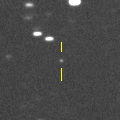
|
Now it is 17.8 mag (Dec. 28, Toshihiko Ikemura, Hirohisa Sato). It will brighten up to 16 mag in March, and it will be observable in good condition.
Date(TT) R.A. (2000) Decl. Delta r Elong. m1 Best Time(A, h)
Feb. 1 11 55.63 44 8.8 1.007 1.832 133 17.1 3:15 (180, 81)
Feb. 8 11 47.86 43 51.9 0.947 1.805 138 17.0 2:40 (180, 81)
|
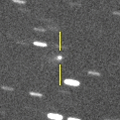
|
Fading. It is observable at 17 mag in good condition in spring. But it will be fainter than 18 mag in June.
Date(TT) R.A. (2000) Decl. Delta r Elong. m1 Best Time(A, h)
Feb. 1 17 2.08 -8 1.5 3.103 2.702 57 17.0 5:32 (309, 31)
Feb. 8 17 12.65 -7 36.9 3.069 2.743 61 17.0 5:28 (312, 34)
|

|
Now it is 17.5 mag (Jan. 5, Toshihiko Ikemura, Hirohisa Sato). It will brighten up to 16.5 mag and will be observable in good condition in March.
Date(TT) R.A. (2000) Decl. Delta r Elong. m1 Best Time(A, h)
Feb. 1 13 19.19 -1 4.9 1.550 2.131 112 17.2 4:38 ( 0, 54)
Feb. 8 13 24.77 -1 19.6 1.482 2.132 118 17.1 4:16 ( 0, 54)
|
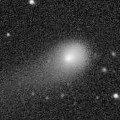
|
Fading. Now it is 17.6 mag (Dec. 27, Toshihiko Ikemura, Hirohisa Sato). It stays observable in good condition for a while. But it will be fainter than 18 mag in April.
Date(TT) R.A. (2000) Decl. Delta r Elong. m1 Best Time(A, h)
Feb. 1 8 17.16 23 53.9 6.001 6.970 169 17.2 23:32 ( 0, 79)
Feb. 8 8 10.91 23 50.0 6.075 7.014 160 17.2 22:58 ( 0, 79)
|
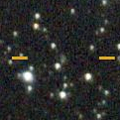
|
Now it is 17.4 mag (Jan. 24, Thomas Lehmann). It will brighten up to 12 mag in winter in 2022. In the Northern Hemisphere, it stays observable in good condition for a long time, although it becomes low from February to March. In the Southern Hemisphere, it is not observable until 2021 November.
Date(TT) R.A. (2000) Decl. Delta r Elong. m1 Best Time(A, h)
Feb. 1 22 37.76 40 27.3 7.343 6.945 62 17.2 18:54 (120, 32)
Feb. 8 22 43.22 40 35.5 7.357 6.899 58 17.2 19:00 (122, 27)
|

|
Now it is 16.8 mag (Jan. 21, Toshihiko Ikemura, Hirohisa Sato). It brightens up to 17 mag until March. It is not observable in the Southern Hemisphere.
Date(TT) R.A. (2000) Decl. Delta r Elong. m1 Best Time(A, h)
Feb. 1 0 30.58 9 37.1 1.670 1.449 59 17.3 18:54 ( 71, 41)
Feb. 8 0 47.46 13 3.2 1.705 1.447 57 17.3 19:00 ( 78, 40)
|
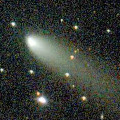
|
It brightened up to 11.4 mag in autumn (Nov. 10, Carlos Labordena). Now it is fading. It has already faded down to 15.6 mag (Jan. 20, Toshihiko Ikemura, Hirohisa Sato). It is observable in excellent condition in the Northern Hemisphere. It stays locating extremely low in the Southern Hemisphere.
Date(TT) R.A. (2000) Decl. Delta r Elong. m1 Best Time(A, h)
Feb. 1 3 35.36 40 8.9 1.538 2.075 108 17.3 18:54 (177, 85)
Feb. 8 3 47.85 39 33.4 1.652 2.123 104 17.7 19:00 (137, 84)
|
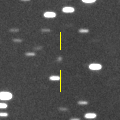
|
Now it is 17.4 mag (Dec. 28, Toshihiko Ikemura, Hirohisa Sato). It stays observable at 16.5 mag for a long time from 2020 to 2021. In the Northern Hemisphere, it is observable in excellent condition for a long time. In the Southern Hemisphere, it is not observable until 2021 summer.
Date(TT) R.A. (2000) Decl. Delta r Elong. m1 Best Time(A, h)
Feb. 1 0 55.11 74 3.0 6.331 6.558 98 17.5 18:54 (165, 46)
Feb. 8 0 55.74 72 51.6 6.383 6.538 94 17.5 19:00 (162, 45)
|

|
Now it is 17.5 mag (Jan. 18, Katsumi Yoshimoto). Hidetaka Sato reported its cometary activity was detected on Dec. 6. It will approach to Sun down to 0.9 a.u. in June, and it is extected to brighten up to 12 mag. In the Southern Hemisphere, it stays observable in good condition for a long time after this. In the Northern Hemisphere, it will be unobservable from late March to late June.
Date(TT) R.A. (2000) Decl. Delta r Elong. m1 Best Time(A, h)
Feb. 1 4 3.50 -27 35.5 2.047 2.368 96 17.8 19:19 ( 0, 27)
Feb. 8 3 59.09 -27 20.1 2.045 2.281 90 17.6 19:00 ( 3, 28)
|
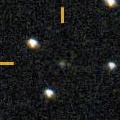
|
Now it is 17.3 mag (Dec. 27, Kunihiro Shima). It is observable at 17-18 mag for a long time from late 2019 to early 2021. It will fade out before it passes the perihelion.
Date(TT) R.A. (2000) Decl. Delta r Elong. m1 Best Time(A, h)
Feb. 1 2 53.76 3 35.1 4.915 5.026 90 17.6 18:54 ( 20, 57)
Feb. 8 2 55.73 4 9.2 5.011 5.013 84 17.7 19:00 ( 34, 55)
|
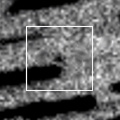
|
It is observable at 17.5 mag in good condition until spring.
Date(TT) R.A. (2000) Decl. Delta r Elong. m1 Best Time(A, h)
Feb. 1 16 46.06 -17 14.6 2.511 2.177 59 17.7 5:32 (319, 26)
Feb. 8 16 59.03 -17 30.8 2.464 2.201 63 17.7 5:28 (321, 28)
|

|
It will brighten up to 13 mag in 2022. In 2020, it is observable at 17.5 mag in good condition in spring. It locates somewhat low in the Southern Hemisphere.
Date(TT) R.A. (2000) Decl. Delta r Elong. m1 Best Time(A, h)
Feb. 1 10 47.49 19 24.6 3.687 4.588 153 17.7 2:07 ( 0, 74)
Feb. 8 10 43.90 19 53.6 3.636 4.576 160 17.7 1:36 ( 0, 75)
|

|
Now it is 17.2 mag (Nov. 25, ATLAS-MLO). It brightened up to 14 mag from autumn to winter in 2018. Now it is fading. It is observable at 17.5 mag in good condition from winter to spring.
Date(TT) R.A. (2000) Decl. Delta r Elong. m1 Best Time(A, h)
Feb. 1 13 48.84 -2 49.3 3.981 4.339 104 17.7 5:07 ( 0, 52)
Feb. 8 13 47.81 -3 1.3 3.913 4.380 112 17.7 4:39 ( 0, 52)
|

|
Now it is 17.7 mag (Dec. 31, Toshihiko Ikemura, Hirohisa Sato). It will be fainter than 18 mag in late April.
Date(TT) R.A. (2000) Decl. Delta r Elong. m1 Best Time(A, h)
Feb. 1 12 45.37 7 57.2 10.129 10.700 123 17.8 4:04 ( 0, 63)
Feb. 8 12 45.09 8 14.1 10.054 10.717 130 17.8 3:36 ( 0, 63)
|

|
Now it is 19.1 mag (Jan. 5, Toshihiko Ikemura, Hirohisa Sato). It will brighten up to 17 mag and will be observable in excellent condition from March to May.
Date(TT) R.A. (2000) Decl. Delta r Elong. m1 Best Time(A, h)
Feb. 1 12 50.02 -6 7.7 1.586 2.219 117 18.0 4:09 ( 0, 49)
Feb. 8 12 54.47 -6 27.6 1.502 2.204 123 17.8 3:45 ( 0, 48)
|
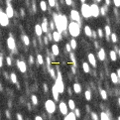
|
It will be observable at 16.5-17 mag from spring in 2020 to summer in 2021.
Date(TT) R.A. (2000) Decl. Delta r Elong. m1 Best Time(A, h)
Feb. 1 19 52.20 19 39.5 5.842 5.128 40 17.9 5:32 (257, 15)
Feb. 8 19 54.65 19 36.5 5.806 5.105 41 17.8 5:28 (259, 20)
|
|
![]()
 C/2015 O1 ( PanSTARRS )
C/2015 O1 ( PanSTARRS ) C/2019 L3 ( ATLAS )
C/2019 L3 ( ATLAS ) 112P/Urata-Niijima
112P/Urata-Niijima 260P/McNaught
260P/McNaught C/2019 T3 ( ATLAS )
C/2019 T3 ( ATLAS ) A/2019 U6
A/2019 U6 173P/Mueller 5
173P/Mueller 5 175P/Hergenrother
175P/Hergenrother 117P/Helin-Roman-Alu 1
117P/Helin-Roman-Alu 1 (944) Hidalgo
(944) Hidalgo C/2014 B1 ( Schwartz )
C/2014 B1 ( Schwartz ) 87P/Bus
87P/Bus C/2017 Y2 ( PanSTARRS )
C/2017 Y2 ( PanSTARRS )![]()







































